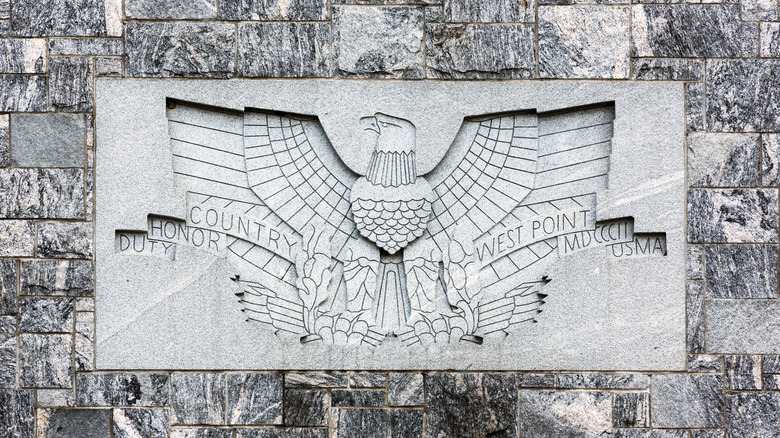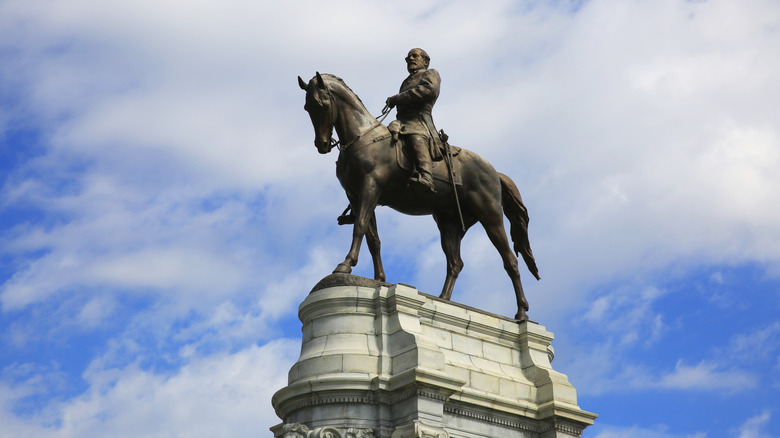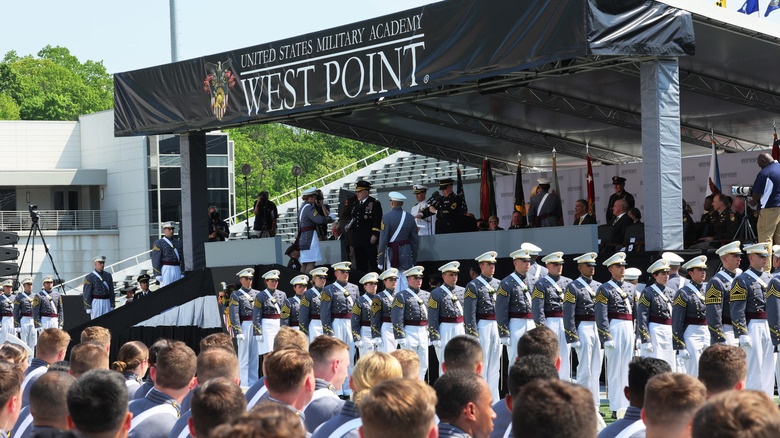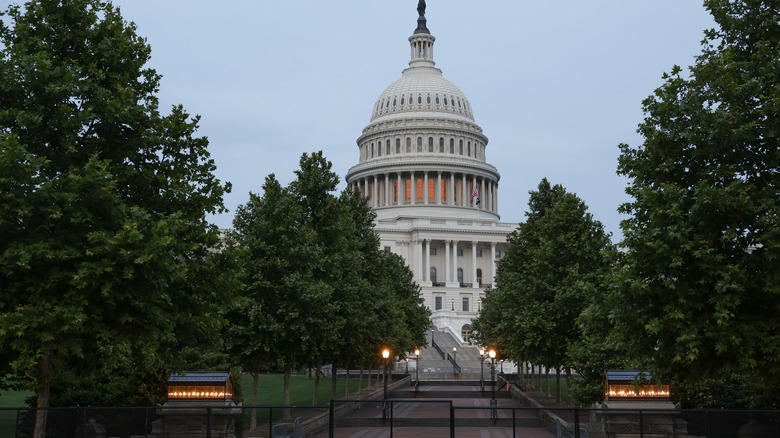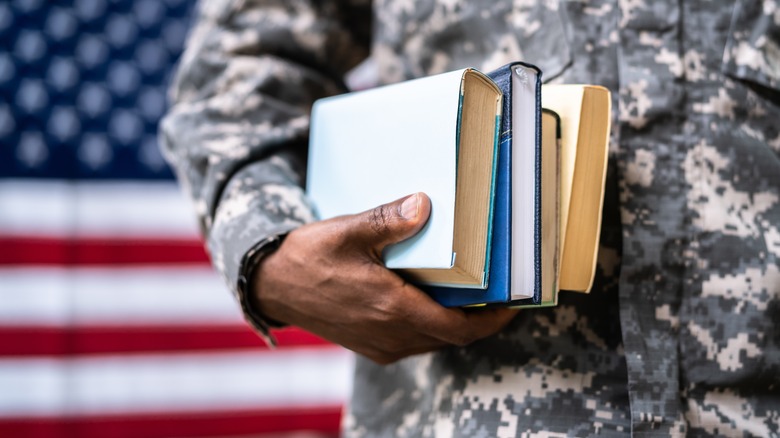The Controversial History Depicted On The Science Hall's Triptych At West Point
In the summer of 2021, the United States went through a sort of nationwide reckoning over its racist past and its current racial issues (via CBS News). Following the death of George Floyd at the hands of Minneapolis police, protests erupted in cities and towns across the country, demanding police accountability. The movement then expanded into a larger evaluation of the role race plays in our commerce and culture. For example, Uncle Ben's Rice became Ben's Original, after decades of being named for, and depicted by a caricature of, a Black rice farmer. Similarly, Aunt Jemima-branded products, also named for and marketed with a Black caricature, reverted to the name Pearl Milling Company.
Also within this context (although it had been going on before the death of George Floyd) was an effort to identify and remove public displays of racism, such as statues of Confederate generals or other racist individuals.
It seems that one of the country's most prestigious institutions of military higher education, West Point, failed to get the memo. As the Miami Herald reports, a congressional commission identified that the school has been displaying a work of art depicting a hooded KKK figure in one of its buildings.
Why are there Confederate monuments anywhere?
Before delving too deeply into the specific case of the West Point artwork featuring a KKK figure, a discussion of why the U.S. has racist and Confederate monuments in the first place is in order.
Following the Civil War, according to Atlanta History Center, a few places here and there erected monuments to the Confederate dead. However, monuments to Confederate soldiers started popping up in earnest around the country in the 1890s, during the worst of the Jim Crow era. Jane Dailey, an associate professor of history at the University of Chicago, via NPR News, explained why. "Most of the people who were involved in erecting the monuments were not necessarily erecting a monument to the past," Daily said. "But were rather, erecting them toward a white supremacist future."
The West Point monument, however, did not come from that era. Rather, it was donated in 1965, according to CNN. Further still, the KKK figure is not the monument's focal point. Rather, it's one of many events in history depicted in the artwork's overall narrative.
The West Point tryptich
A triptych, for those not familiar, is a work of art depicted in three parts, such as three panels of a painting, as Art in Context explains. In the case of the West Point triptych, the art isn't painted on a canvas but, rather, is a bronze-relief sculpture, of a sort.
As CNN reports, the monument was donated in 1965 and was intended to honor the West Point graduates who served in World War II and the Korean War. The piece's sculptor, Laura Gardin Fraser, was apparently going for a larger look at U.S. history and the role West Point graduates have played in it. Per West Point's public relations office (via The Washington Post), "[Fraser] wanted to create art that depicted 'historical incidents or persons' that symbolized the principled events of that time, thereby documenting both tragedy and triumph in our nation's history."
One such "historical person" is a hooded KKK figure holding a gun, the words "Ku Klux Klan" emblazoned beneath him. The figure, which appears to represent an archetype rather than a specific person, is a small part of the work's overall presentation, which also includes other visual metaphorsl. "Among many other symbols, the triptych also includes individuals who were instrumental in shaping principal events of that time, and symbols like the Tree of Life that depict how our nation has flourished despite its tragedies," said the institution (via the Miami Herald).
A congressional commission identifies the monument but doesn't specify any action
The identification of the West Point triptych with a KKK figure on it, and the fact that its existence could be problematic, didn't come from within the military academy. Even though it's been there for nearly 60 years, and even though for six decades cadets have walked right past it as they traverse the university's science building, it wasn't anyone affiliated with the institution that revealed its presence. Rather, it was a congressional commission.
The Naming Commission was tasked with identifying and, if necessary, renaming or removing "Confederate assets" on military bases and the like. The newest report, which identified the West Point triptych, recommended a few changes to the art piece, according to the Miami Herald, including "remov[ing] the names and images from the panels that specifically commemorate individuals who voluntarily served in the Confederacy." However, the commission also says that references to Robert E. Lee can stay because the art represents his time at West Point, and not in the Confederate Army.
As for the KKK figure, the commission didn't provide any recommendations. "The marker falls outside the remit of the Commission; however, there are clearly ties in the KKK to the Confederacy," the report notes.
The future of the West Point triptych
For now, the future of the West Point triptych and, in particular, the KKK figure at the center of this controversy, remains uncertain. As mentioned above, the congressional commission that identified the piece made no specific recommendations about the figure. West Point, for its part, hasn't mapped out the monument's future just yet.
"West Point does not accept, condone, or promote racism, sexism, or any other biases. The Academy continues to graduate its most diverse classes ever with respect to ethnicity, gender, experience, and background," West Point's public affairs office said in a statement, via CNN.
However, as for the future of the monument itself, the institution was less clear, stating only that the university is "reviewing the recommendations" of the Naming Commission's report and promised to "collaborate with the Department of the Army" and will make any changes necessary, once they're approved. What that means remains unclear, as of this writing.
Meanwhile, the commission also identified 12 other "assets" — plaques, monuments, statues, etc. — at West Point that do need to be changed, as well as three such assets at the U.S. Naval Academy.
